英语祈使句和反意疑问句的基本结构和用法
- 格式:doc
- 大小:57.50 KB
- 文档页数:6
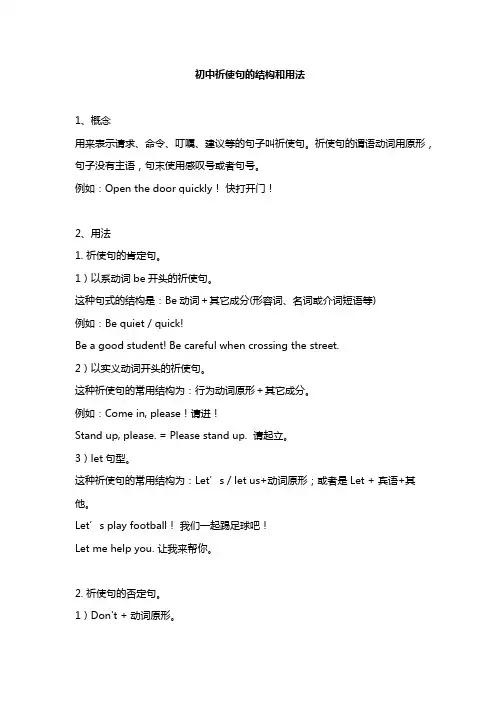
初中祈使句的结构和用法1、概念用来表示请求、命令、叮嘱、建议等的句子叫祈使句。
祈使句的谓语动词用原形,句子没有主语,句末使用感叹号或者句号。
例如:Open the door quickly!快打开门!2、用法1. 祈使句的肯定句。
1)以系动词be开头的祈使句。
这种句式的结构是:Be动词+其它成分(形容词、名词或介词短语等)例如:Be quiet / quick!Be a good student! Be careful when crossing the street.2)以实义动词开头的祈使句。
这种祈使句的常用结构为:行为动词原形+其它成分。
例如:Come in, please!请进!Stand up, please. = Please stand up. 请起立。
3)let句型。
这种祈使句的常用结构为:Let’s / let us+动词原形;或者是Let + 宾语+其他。
Let’s play football!我们一起踢足球吧!Let me help you. 让我来帮你。
2. 祈使句的否定句。
1)Don't + 动词原形。
Don't be careless. 别粗心。
Don’t be late again. 不要再迟到。
Don't let them play with fire. 别让他们玩火。
Don’t look at your books. 不要看书。
2)Let引起的祈使句的否定形式。
a. Let's ( Let sb. ) + not + 动词原形。
Let's not say anything about it. 对于这件事,咱们什么也别说。
Let them not play with fire. 别让他们玩火。
b. Don’t+ let+宾语+动词原形+其他。
Don’t let Jim do that. 别让吉姆做那事。
Don’t let us go, please. 请不要让我们走。
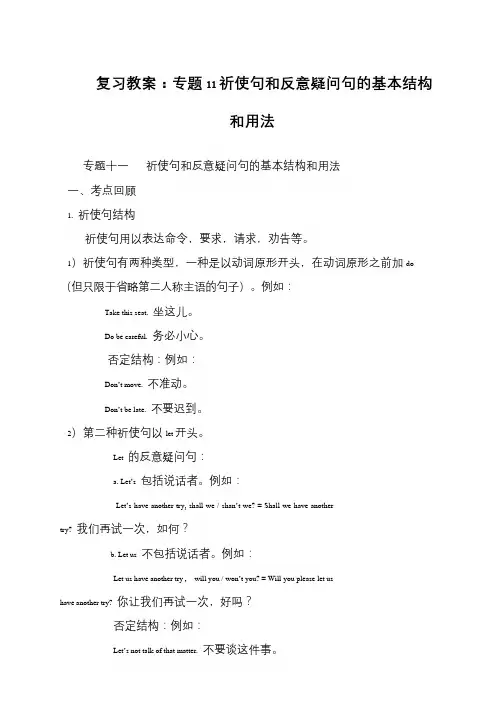
复习教案:专题11 祈使句和反意疑问句的基本结构
和用法
专题十一祈使句和反意疑问句的基本结构和用法
一、考点回顾
1. 祈使句结构
祈使句用以表达命令,要求,请求,劝告等。
1)祈使句有两种类型,一种是以动词原形开头,在动词原形之前加do (但只限于省略第二人称主语的句子)。
例如:
Take this seat. 坐这儿。
Do be careful. 务必小心。
否定结构:例如:
Don’t move. 不准动。
Don’t be late. 不要迟到。
2)第二种祈使句以let 开头。
Let 的反意疑问句:
a. Let’s包括说话者。
例如:
Let’s have another try, shall we / shan’t we? = Shall we have another
try? 我们再试一次,如何?
b. Let us 不包括说话者。
例如:
Let us have another try,will you / won’t you? = Will you please let us
have another try? 你让我们再试一次,好吗?
否定结构:例如:
Let’s not talk of that matter. 不要谈这件事。

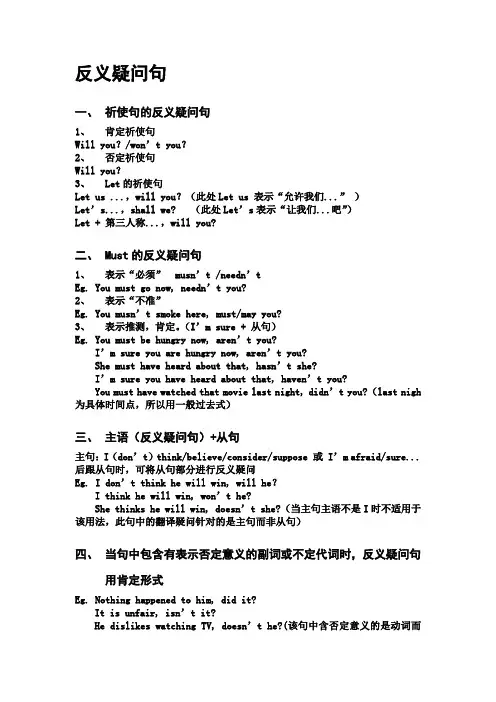
反义疑问句一、祈使句的反义疑问句1、肯定祈使句Will you?/won’t you?2、否定祈使句Will you?3、Let的祈使句Let us ...,will you?(此处Let us 表示“允许我们...”)Let’s...,shall we? (此处Let’s表示“让我们...吧”)Let + 第三人称...,will you?二、Must的反义疑问句1、表示“必须” musn’t /needn’tEg. You must go now, needn’t you?2、表示“不准”Eg. You musn’t smoke here, must/may you?3、表示推测,肯定。
(I’m sure + 从句)Eg. You must be hungry now, aren’t you?I’m sure you are hungry now, aren’t you?She must have heard about that, hasn’t she?I’m sure you have heard about that, haven’t you?You must have watched that movie last night, didn’t you?(last nigh 为具体时间点,所以用一般过去式)三、主语(反义疑问句)+从句主句:I(don’t)think/believe/consider/suppose 或 I’m afraid/sure...后跟从句时,可将从句部分进行反义疑问Eg. I don’t think he will win, will he?I think he will win, won’t he?She thinks he will win, doesn’t she?(当主句主语不是I时不适用于该用法,此句中的翻译疑问针对的是主句而非从句)四、当句中包含有表示否定意义的副词或不定代词时,反义疑问句用肯定形式Eg. Nothing happened to him, did it?It is unfair, isn’t it?He dislikes watching TV, doesn’t he?(该句中含否定意义的是动词而非副词或不定代词,因此不适用于该用法,反义疑问句仍然使用否定形式)五、反义疑问句的回答反义疑问句的回答针对被提问部分的谓语动词,且与回答句前部分的Yes和No 保持一致Eg. A: You haven’t lost the ticket, have you?B: D I know it’s hard to get another one at this moment.A. Yes, I haven’tB. No, I haveC. I hope soD. I’m afraid not六、陈述部分的主语与反义疑问句主语保持一致的情况1、OneEg. One can’t be too careful when driving a car, can one/he?一个人在开车的时候再怎么小心也不为过。
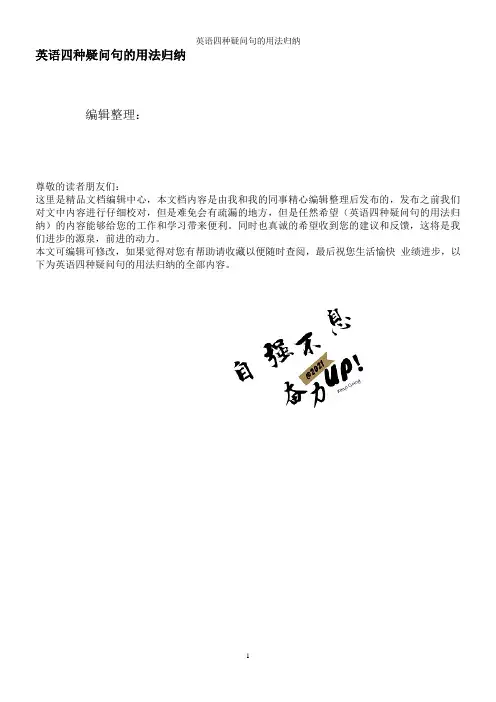
英语四种疑问句的用法归纳编辑整理:尊敬的读者朋友们:这里是精品文档编辑中心,本文档内容是由我和我的同事精心编辑整理后发布的,发布之前我们对文中内容进行仔细校对,但是难免会有疏漏的地方,但是任然希望(英语四种疑问句的用法归纳)的内容能够给您的工作和学习带来便利。
同时也真诚的希望收到您的建议和反馈,这将是我们进步的源泉,前进的动力。
本文可编辑可修改,如果觉得对您有帮助请收藏以便随时查阅,最后祝您生活愉快业绩进步,以下为英语四种疑问句的用法归纳的全部内容。
英语四种疑问句的用法归纳一、学习一般疑问句的五个要点就全句提出问题,希望对方给予肯定或否定答复的问句,叫做一般疑问句.回答时要用Yes或No来开头,句末用问号,朗读时用升调。
(一)、一般疑问句的基本结构1. 如果谓语中有情态动词、助动词或be,将这些词移到主语之前。
如:Eg: Can you dance? 你会跳舞吗?Will he go there tomorrow?他明天去那里?Are you a student? 你是学生吗?2。
如果谓语中没有情态动词、助动词或be,就在主语前加助动词do(does、did) ,原来的动词都用原形.如:Eg: Do you like English? 你喜欢英语吗?Does your brother like English?你的兄弟喜欢英语吗?Did you sleep well last night? 你昨晚睡得好吗?注:have做助动词时,将其移至主语前;作“有”解时也可以将其移至主语前;不是作“有"解的为行为动词时,其疑问式和其他行为动词一样要在主语前加do(does、did) .如:Eg: Has he gone to England?他到英国去了?Have you (=Do you have) a car? 你有汽车吗?Do you have lunch at school? 你是在学校吃中饭的吗?(二)、一般疑问句的简略回答Eg:—Can you swim?你会游泳吗?—Yes, I can。
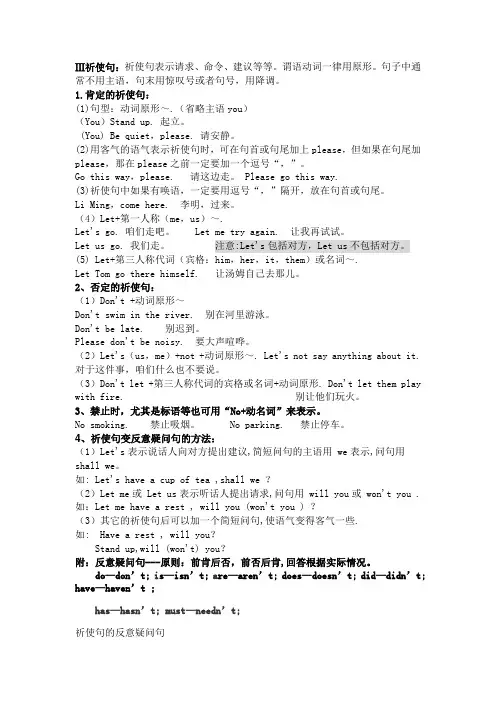
Ⅲ祈使句:祈使句表示请求、命令、建议等等。
谓语动词一律用原形。
句子中通常不用主语,句末用惊叹号或者句号,用降调。
1.肯定的祈使句:(1)句型:动词原形~.(省略主语you)(You)Stand up. 起立。
(You) Be quiet,please. 请安静。
(2)用客气的语气表示祈使句时,可在句首或句尾加上please,但如果在句尾加please,那在please之前一定要加一个逗号“,”。
Go this way,please. 请这边走。
Please go this way.(3)祈使句中如果有唤语,一定要用逗号“,”隔开,放在句首或句尾。
Li Ming,come here. 李明,过来。
(4)Let+第一人称(me,us)~.Let's go. 咱们走吧。
Let me try again. 让我再试试。
Let us go. 我们走。
注意:Let's包括对方,Let us不包括对方。
(5) Let+第三人称代词(宾格:him,her,it,them)或名词~.Let Tom go there himself. 让汤姆自己去那儿。
2、否定的祈使句:(1)Don't +动词原形~Don't swim in the river. 别在河里游泳。
Don't be late. 别迟到。
Please don't be noisy. 要大声喧哗。
(2)Let's(us,me)+not +动词原形~. Let's not say anything about it. 对于这件事,咱们什么也不要说。
(3)Don't let +第三人称代词的宾格或名词+动词原形. Don't let them play with fire. 别让他们玩火。
3、禁止时,尤其是标语等也可用“No+动名词”来表示。
No smoking. 禁止吸烟。
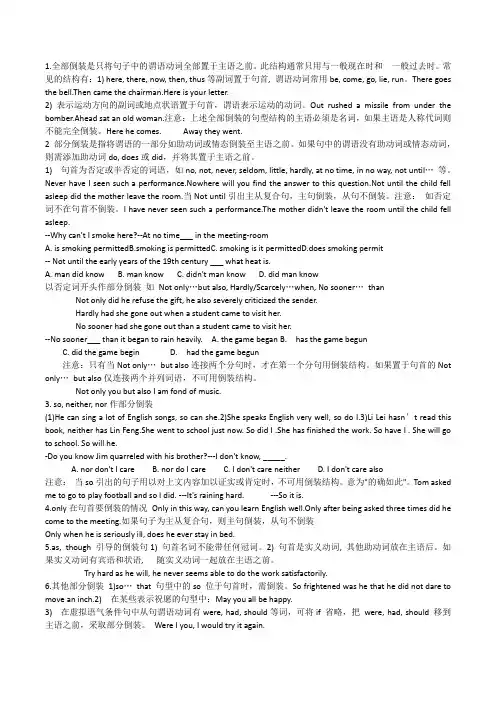
1.全部倒装是只将句子中的谓语动词全部置于主语之前。
此结构通常只用与一般现在时和一般过去时。
常见的结构有:1) here, there, now, then, thus等副词置于句首, 谓语动词常用be, come, go, lie, run。
There goes the bell.Then came the chairman.Here is your letter.2) 表示运动方向的副词或地点状语置于句首,谓语表示运动的动词。
Out rushed a missile from under the bomber.Ahead sat an old woman.注意:上述全部倒装的句型结构的主语必须是名词,如果主语是人称代词则不能完全倒装。
Here he comes.Away they went.2 部分倒装是指将谓语的一部分如助动词或情态倒装至主语之前。
如果句中的谓语没有助动词或情态动词,则需添加助动词do, does或did,并将其置于主语之前。
1)句首为否定或半否定的词语,如no, not, never, seldom, little, hardly, at no time, in no way, not until…等。
Never have I seen such a performance.Nowhere will you find the answer to this question.Not until the child fell asleep did the mother leave the room.当Not until引出主从复合句,主句倒装,从句不倒装。
注意:如否定词不在句首不倒装。
I have never seen such a performance.The mother didn't leave the room until the child fell asleep.--Why can't I smoke here?--At no time___ in the meeting-roomA. is smoking permittedB.smoking is permittedC. smoking is it permittedD.does smoking permit-- Not until the early years of the 19th century ___ what heat is.A. man did knowB. man knowC. didn't man knowD. did man know以否定词开头作部分倒装如Not only…but also, Hardly/Scarcely…when, No sooner…than Not only did he refuse the gift, he also severely criticized the sender.Hardly had she gone out when a student came to visit her.No sooner had she gone out than a student came to visit her.--No sooner___ than it began to rain heavily. A. the game began B.has the game begunC. did the game beginD.had the game begun注意:只有当Not only…but also连接两个分句时,才在第一个分句用倒装结构。

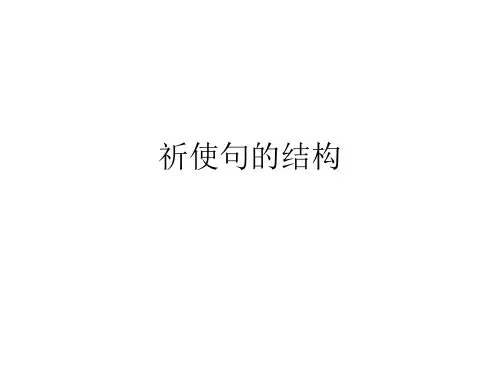
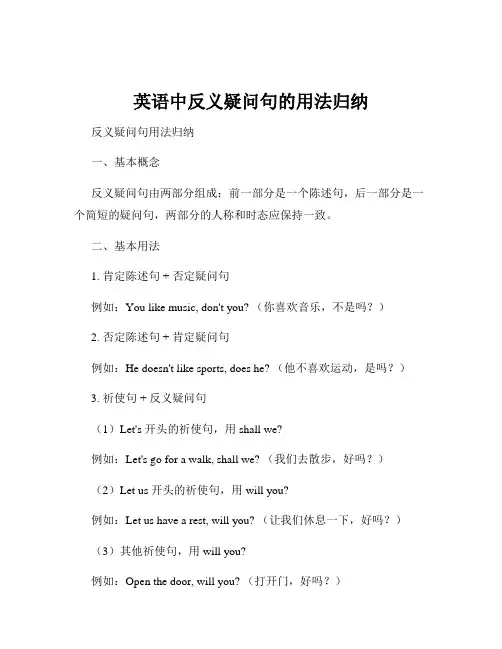
英语中反义疑问句的用法归纳反义疑问句用法归纳一、基本概念反义疑问句由两部分组成:前一部分是一个陈述句,后一部分是一个简短的疑问句,两部分的人称和时态应保持一致。
二、基本用法1. 肯定陈述句 + 否定疑问句例如:You like music, don't you? (你喜欢音乐,不是吗?)2. 否定陈述句 + 肯定疑问句例如:He doesn't like sports, does he? (他不喜欢运动,是吗?)3. 祈使句 + 反义疑问句(1)Let's 开头的祈使句,用 shall we?例如:Let's go for a walk, shall we? (我们去散步,好吗?)(2)Let us 开头的祈使句,用 will you?例如:Let us have a rest, will you? (让我们休息一下,好吗?)(3)其他祈使句,用 will you?例如:Open the door, will you? (打开门,好吗?)4. 含有 must 的反义疑问句(1)must 表示“必须”时,用 needn't例如:You must finish your homework today, needn't you? (你今天必须完成作业,不是吗?)(2)must 表示推测“一定,肯定”时,根据实际情况而定例如:He must be very tired, isn't he? (他一定很累了,不是吗?)5. 含有否定词的反义疑问句当陈述句中有 never, few, little, nothing, nobody 等否定词时,反义疑问句用肯定形式。
例如:There is nothing in the box, is there? (盒子里什么都没有,是吗?)三、固定搭配1. “I am + 表语”,反义疑问句用“aren't I”例如:I'm late, aren't I? (我迟到了,不是吗?)2. 陈述部分是“there be”结构,反义疑问句用“be there”例如:There is a book on the desk, isn't there? (桌子上有一本书,不是吗?)3. 当陈述部分主语是不定代词 everyone, somebody, nobody, everyone 等时,反义疑问句用 they 或 he例如:Everyone is here, aren't they? (大家都在这儿,不是吗?)4. 当陈述部分主语是 this, that 时,反义疑问句用 it;当陈述部分主语是 these, those 时,反义疑问句用 they例如:This is a pen, isn't it? (这是一支钢笔,不是吗?)5. 当陈述部分是主从复合句时,反义疑问句与主句的主语和谓语保持一致例如:He said he would come, didn't he? (他说他会来,不是吗?)双语例句:1. I have a lot of friends, don't I? (我有很多朋友,不是吗?)2. She doesn't speak French, does she? (她不会说法语,是吗?)3. Have a cup of coffee, will you? (喝杯咖啡,好吗?)4. We should study hard, shouldn't we? (我们应该努力学习,不是吗?)5. They have been to Beijing, haven't they? (他们去过北京,不是吗?)6. You aren't a doctor, are you? (你不是医生,对吧?)7. There are some apples on the tree, aren't there? (树上有一些苹果,不是吗?)8. Nobody knows the answer, do they? (没人知道答案,对吧?)9. This isn't your book, is it? (这不是你的书,对吧?)10. Those are beautiful flowers, aren't they? (那些是漂亮的花,不是吗?)11. He can swim very well, can't he? (他游泳游得很好,不是吗?)12. She never tells lies, does she? (她从不说谎,对吧?)13. We had a great time yesterday, didn't we? (我们昨天玩得很开心,不是吗?)14. If it rains tomorrow, we won't go hiking, will we? (如果明天下雨,我们就不去徒步了,对吧?)15. You think he is right, don't you? (你认为他是对的,不是吗?)16. Mary has few friends here, does she? (玛丽在这儿几乎没朋友,对吧?)17. The boy doesn't like vegetables, does he? (这男孩不喜欢蔬菜,是吗?)18. Everyone wants to be happy, don't they? (每个人都想快乐,不是吗?)19. I'm a good student, aren't I? (我是个好学生,不是吗?)20. He told you the truth, didn't he? (他告诉你真相了,不是吗?)。
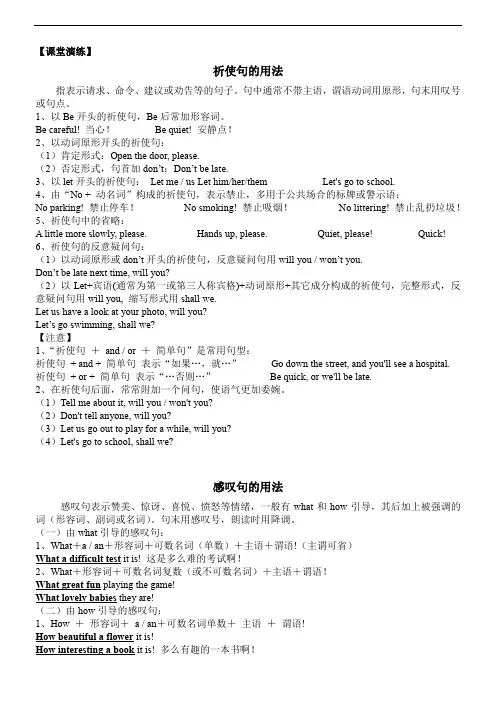
【课堂演练】祈使句的用法指表示请求、命令、建议或劝告等的句子。
句中通常不带主语,谓语动词用原形,句末用叹号或句点。
1、以Be开头的祈使句,Be后常加形容词。
Be careful! 当心!Be quiet! 安静点!2、以动词原形开头的祈使句:(1)肯定形式:Open the door, please.(2)否定形式,句首加don’t:Don’t be late.3、以let开头的祈使句:Let me/us Let him/her/them Let's go to school.4、由“No + 动名词”构成的祈使句,表示禁止,多用于公共场合的标牌或警示语:No parking! 禁止停车!No smoking! 禁止吸烟!No littering! 禁止乱扔垃圾!5、祈使句中的省略:A little more slowly, please. Hands up, please.Quiet, please! Quick!6、祈使句的反意疑问句:(1)以动词原形或don’t开头的祈使句,反意疑问句用will you / won’t you.Don’t be late next time, will you?(2)以Let+宾语(通常为第一或第三人称宾格)+动词原形+其它成分构成的祈使句,完整形式,反意疑问句用will you, 缩写形式用shall we.Let us have a look at your photo, will you?Let’s go swimming, shall we?【注意】1、“祈使句+and/or +简单句”是常用句型:祈使句+ and + 简单句表示“如果…,就…”Go down the street,and you'll see a hospital.祈使句+ or + 简单句表示“…否则…”Be quick,or we'll be late.2、在祈使句后面,常常附加一个问句,使语气更加委婉。
祈使句反义疑问句用法祈使句反义疑问句用法祈使句是一种用来表达命令、请求和建议的句子,它通常使用动词原形,而不带主语。
例如:“开门!”、“来一杯咖啡。
”、“别打扰我。
”等等。
相比之下,反义疑问句是一种用来表达反问的句型,通常由两部分组成:一个陈述句和一个疑问句,疑问句往往与陈述句意义相反或形成对比。
例如:“你不吃饭吗?”、“他是不是很聪明?”、“天气真好,是不是?”等等。
下面我们来探讨一下祈使句和反义疑问句的用法。
祈使句和反义疑问句的基本规则祈使句和反义疑问句的用法都有一些基本规则,学会这些规则对我们正确理解和使用这两种句型非常重要。
祈使句的基本规则:1. 祈使句通常使用动词原形,并且不带主语。
2. 如果我们要使用主语,一般使用第二人称,例如:“你来看看这里。
”3. 祈使句的语气通常较为强烈,表示命令、请求或建议等。
反义疑问句的基本规则:1. 反义疑问句通常由两部分组成:一个陈述句和一个疑问句。
2. 疑问句的形式通常是助动词加主语加动词,例如:“你去吗?”3. 疑问句通常与陈述句的意义相反或形成对比,例如:“你不是学生吗?”4. 反义疑问句的语气通常比较委婉,表示询问、质疑或确认等。
祈使句反义疑问句的使用场景祈使句和反义疑问句的使用场景非常广泛,下面我们分别来看一下它们的具体运用。
祈使句的使用场景:1. 祈使句常用于口头交流中,例如工作中的命令或家庭生活中的请求等。
2. 祈使句适用于需要快速明确表达观点或需求的场景。
3. 祈使句常用于向下级员工或下属下达指令。
4. 祈使句也可用于写作中的指示或命令等场景。
反义疑问句的使用场景:1. 反义疑问句常用于口语中,可以有效缓和语气。
2. 反义疑问句适用于询问对方的看法或意见。
3. 反义疑问句可以用来确认某个事实,例如向他人确定某个消息是否准确。
4. 反义疑问句也可用于写作中的感叹、疑问等场景。
祈使句反义疑问句的注意事项祈使句和反义疑问句虽然用法广泛,但在具体使用时也需要注意一些事项。
反义疑问句一、反意疑问句的构成形式eg: John is kind, isn't he?约翰很和蔼,不是吗?eg: The man went away, didn't he?那个男人走开了,不是吗?eg: You have paid the gas bill, haven’t you你已经付了煤气费,不是吗?前肯后否:肯定陈述句+简略否定问句。
eg: She is not good at playing the violin, is she?她不擅长拉小提琴,是吗eg: They haven't been told the truth, have they?他们还没有被告知事情的真相,是吗?eg: He can' t read, can he?他不识字,是吗?前否后肯:否定陈述句+简略肯定问句。
二、反意疑问句的回答反意疑问句一般用yes或no回答,但要注意时态及人称代词的呼应。
在“前否后肯”的句子中,答语中的yes的含义为“不”,no的含义为“是”。
eg:-He is s a doctor, isn't he?他是医生,是吗?Yes, he is. 是, 他是医生No, he isn't. 不, 他不是医生eg:- -He isn' t a doctor, is he?他不是医生,是吗Yes, he is. 不, 他是医生NO, he isn't. 是, 他不是医生。
Yes, 表示陈述语序,表示肯定含义祈使句(1)第二人称作主语的祈使句第二人称作主语的祈使句通常省略主语you,用动词原形开头.eg: ( You)Get up quickly, or you'll be late for school.快点起床!否则你上学会迟到的。
eg: (You) Please come and meet my family.请来见见我的家人吧。
祈使句&反意疑问句&省略句-特殊句型(重难考点精讲练)距离高考还有一段时间,不少有经验的老师都会提醒考生,愈是临近高考,能否咬紧牙关、学会自我调节,态度是否主动积极,安排是否科学合理,能不能保持良好的心态、以饱满的情绪迎接挑战,其效果往往大不一样。
以下是本人从事10多年教学经验总结出的以下学习资料,希望可以帮助大家提高答题的正确率,希望对你有所帮助,有志者事竟成!养成良好的答题习惯,是决定高考英语成败的决定性因素之一。
做题前,要认真阅读题目要求、题干和选项,并对答案内容作出合理预测;答题时,切忌跟着感觉走,最好按照题目序号来做,不会的或存在疑问的,要做好标记,要善于发现,找到题目的题眼所在,规范答题,书写工整;答题完毕时,要认真检查,查漏补缺,纠正错误。
总之,在最后的复习阶段,学生们不要加大练习量。
在这个时候,学生要尽快找到适合自己的答题方式,最重要的是以平常心去面对考试。
英语最后的复习要树立信心,考试的时候遇到难题要想“别人也难”,遇到容易的则要想“细心审题”。
越到最后,考生越要回归基础,单词最好再梳理一遍,这样有利于提高阅读理解的效率。
另附高考复习方法和考前30天冲刺复习方法。
祈使句一、祈使句的句式特征祈使句常常是表达说话人对对方的劝告、叮嘱、请求或命令等。
因此,祈使句中一般没有主语,但根据其句意,实际上是省略了主语you。
祈使句句末用感叹号或句号,朗读时,常用降调。
在表达请求或劝告时,在祈使句前或句末可加上please,以使句子的语气更加缓和或客气。
祈使句一般没有时态的变化,也不能与情态动词连用。
Keep off the grass! 勿踩踏草地!Put the boxes in the small room. 把那些盒子放到那个小房间里。
二、祈使句的肯定句式祈使句的肯定句式一般分为以下三种类型:1. 行为动词原形+其他成分。
Make sentences after the model. 根据例句造句。
高考英语语法要点细讲精练祈使句,反意疑问句和感叹句【考纲解读】从近几年的高考题可以看出,在四种简单句型中,考查的重点比较集中,主要考查反意疑问句和祈使句。
作为考查点,在全国卷及地方卷单项填空中每年都以灵活、多变的形式出现。
根据英语语言特点、简单句的考查今后仍是热点。
考查的重点是:祈使句和含有宾语从句的主从复合句的反意疑问句及句尾的附加成分等。
主要考点有:1. 祈使句的判断2. 祈使句固定结构3. 反意疑问句一般用法及特殊用法【知识要点】一、简单句只有一个主语(或并列主语)和一个谓语(或并列谓语)的句子叫简单句。
按照句子的功能,简单句可分为4类:陈述句、疑问句、祈使句、感叹句。
其中陈述句中的否定式、疑问句中的反意疑问句以及感叹句的结构多为考查重点,应重点掌握。
以下将对此作重点分析。
1.陈述句陈述句包括肯定式和否定式两种(肯定式暂略)。
注意以下有关否定结构的问题:He had hardly any schooling before liberation.Not both of them want to go.(=Both of them don’t want to go.)All that glitters is not gold.None of these answers are/is correct.We don’t believe that he can do that.—Is Xiao Ming coming?—I don’t suppose so./I suppose not./I suppose so.hope和be afraid的肯定和否定答语分别为:I hope so./I hope not.及I’m afraid so./I’m afraid not.2.疑问句疑问句分为一般疑问句、特殊疑问句、选择疑问句和反意疑问句。
现主要介绍反意疑问句构成。
形式:句子+简短的疑问句(1)前面若有多个句子并列,则以最后一个句子为准;若前面部分为主从复合句,一般来说,以主句为准;但若主从复合句的主句谓语动词是think,believe,suppose,guess等,主语又是第一人称且为一般现在时、谓语又没有任何副词修饰时,简短疑问部分的动词、时态、人称则以从句为准,而肯、否定形式依主句而定。
祈使句反义疑问句的用法总结1.引言1.1 概述概述部分内容:本文主要探讨祈使句反义疑问句的用法。
祈使句是用来表达命令、建议、请求等具有使役作用的句子,而反义疑问句则是用来表示说话者对所说内容的不确定或期望得到对方确认的句子。
祈使句反义疑问句的结构相对简单,但在实际应用中却具有一定的复杂性和灵活性。
在本文的正文部分,将详细介绍祈使句的用法和反义疑问句的用法。
首先,我们将介绍祈使句的基本结构和用法,包括肯定祈使句和否定祈使句的表达方式。
然后,我们将探讨反义疑问句的构成和用法,以及如何根据祈使句的语气和情境来选择适当的反义疑问句形式。
在结论部分,将对祈使句反义疑问句的用法进行总结和归纳,强调其在日常交流和书面表达中的重要性。
祈使句反义疑问句不仅能够增加交流的准确性和互动性,还能够表达说话者的态度和情感,因此在实际应用中具有广泛的适用性和重要性。
通过本文的阅读,读者将对祈使句反义疑问句的用法有一个清晰的了解,并能够在实际应用中灵活运用,提高自己的语言表达能力。
同时,本文也为相关领域的研究者提供了一个扎实的基础,可以进一步深入研究和探索祈使句反义疑问句的语法规律和语义特点。
1.2文章结构1.2 文章结构文章将分为引言、正文和结论三个部分,每个部分将侧重不同的内容和目标。
引言部分将概述祈使句反义疑问句的用法,并说明文章的目的和结构。
这将给读者一个整体的了解,引导他们更好地理解和阅读接下来的内容。
正文部分将进一步探讨祈使句和反义疑问句的用法。
首先,将介绍祈使句的定义和用法,包括用于表示命令、请求、建议等情况的简洁句式。
然后,将介绍反义疑问句的定义和用法,包括用于陈述句后提出表达确认的疑问句。
在介绍每种用法时,将提供具体的例子和解释,以帮助读者更好地理解。
结论部分将对祈使句反义疑问句的用法进行总结,并强调其重要性。
总结部分将回顾祈使句和反义疑问句的基本用法,强调其在语言表达中的重要性和灵活性。
然后,将探讨祈使句反义疑问句的重要性,并讨论如何在不同情境下使用这些句式来达到更好的沟通效果。
祈使句和反意疑问句的基本结构和用法一、考点回顾1. 祈使句结构祈使句用以表达命令,要求,请求,劝告等。
1)祈使句有两种类型,一种是以动词原形开头,在动词原形之前加do (但只限于省略第二人称主语的句子)。
例如:Take this seat. 坐这儿。
Do be careful. 务必小心。
否定结构:例如:Don't move. 不准动。
Don't be late. 不要迟到。
2)第二种祈使句以let开头。
Let 的反意疑问句:a. Let's 包括说话者。
例如:Let's have another try, shall we / shan't we? = Shall we have another try? 我们再试一次,如何?b. Let us 不包括说话者。
例如:Let us have another try,will you / won't you? = Will you please let us have another try? 你让我们再试一次,好吗?否定结构:例如:Let's not talk of that matter. 不要谈这件事。
Let us not talk of that matter. 你不要让我们谈这件事3)常考句型祈使句+and/or/otherwise+将来时Study hard and you’ll succeed2. 反意疑问句1)陈述部分的主语是I,疑问部分要用aren't I。
例如:I'm as tall as your sister, aren't I? 我跟你姐一样高,对吗?2)陈述部分的谓语是wish,疑问部分要用may +主语。
例如:I wish to have a word with you, may I? 我想与你说句话,行吗?3)陈述部分用no, nothing, nobody, never, few, seldom, hardly, rarely, little等否定含义的词时,疑问部分用肯定含义。
例如:Some plants never blown (开花), do they ? 有些植物从不开花,对吗?4)含有ought to 的反意疑问句,陈述部分是肯定的,疑问部分用shouldn't / oughtn't +主语。
例如:He ought to know what to do, oughtn't he? / shouldn't he? 他应该知道该做什么,对吗?5)陈述部分有have to +v. (had to + v.),疑问部分常用don't +主语(didn't +主语)。
例如:We have to get there at eight tomorrow, don't we? 我们要在明天早上八点到达那儿,是吗?6)陈述部分的谓语是used to 时,疑问部分用didn't +主语或usedn't +主语。
例如:He used to take pictures there, didn't he? / usedn't he? 他以前常在那儿拍照,是吗?7)陈述部分有had better + v. 疑问句部分用hadn't you? 例如:You'd better read it by yourself, hadn't you? 你最好自己去读,好吗?8)陈述部分有would rather +v.,疑问部分多用wouldn't +主语。
例如:He would rather read it ten times than recite it, wouldn't he? 他宁可读十遍也不愿意背诵,是吗?9)陈述部分有You'd like to +v. 疑问部分用wouldn't +主语。
例如:You'd like to go with me, wouldn't you? 你想和我们一块去,对吗?10)陈述部分有must 的疑问句,疑问部分根据实际情况而定。
例如:He must be a doctor, isn't he? 他肯定是医生,是吗?You must have studied English for three years, haven't you? / didn't you? 你一定读过三年英语,对吗?He must have finished it yesterday, didn't he? 他肯定是在昨天完成任务的,是吗?11)感叹句中,疑问部分用be +主语。
例如:What colors, aren't they? 多漂亮的颜色,是吗?12)陈述部分由neither… nor, either… or 连接的并列主语时,疑问部分根据其实际逻辑意义而定。
Neither you nor I am engineer, are we? 你不是工程师,我也不是,对吗?13)陈述部分主语是指示代词或不定代词everything, that, nothing, this, 疑问部分主语用it。
例如:Everything is ready, isn't it? 一切就绪,是吗?14)陈述部分为主语从句或并列复合句,疑问部分有三种情况:a. 并列复合句疑问部分,谓语动词根据邻近从句的谓语而定。
例如:Mr. Smith had been to Beijing for several times, he should have been in China now, shouldn't he?史密斯先生曾几次去过北京,按理说他现在应该在中国,是吗?b. 带有定语从句,宾语从句的主从复合句,疑问部分谓语根据主句的谓语而定。
例如:He said he wanted to visit Japan, didn't he? 他说他想去日本看看,他是那样说的吗?c. 陈述部分主句为第一人称,谓语是think, believe, expect, suppose, imagine等引导的定语从句,疑问部分与宾语从句相对应构成反意疑问句。
例如:I don't think he is bright, is he? 我认为他并不聪明,是吗?We believe she can do it better, can't she? 我们相信她能做得更好,她能吗?15)陈述部分主语是不定代词everybody, anyone, somebody, nobody, no one等,疑问部分常用复数they,有时也用单数he。
例如:Everyone knows the answer, don't they?(does he?)人人都知道答案,是这样吧?Nobody knows about it, do they? (does he?)没人知道这件事,是吧?16)带情态动词dare或need的反意疑问句,疑问部分常用need (dare )+主语。
例如:We need not do it again, need we ? 我们不必重做一遍,是吗?He dare not say so, dare he? 他不敢这样说,是吗?当dare, need 为实义动词时,疑问部分用助动词do + 主语。
例如:She doesn't dare to go home alone, does she? 她不敢独自回家,是吗?17)省去主语的祈使句的反意疑问句,疑问部分用will you。
例如:Don't do that again, will you? 别再这样做,好吗?Go with me, will you / won't you ? 跟我走吧,好吗?注意:Let's 开头的祈使句,后用shall we?Let us 开头的祈使句,后用will you? 例如:Let's go and listen to the music, shall we? 一起去听音乐,好吗?Let us wait for you in the reading-room, will you ? 你让我们在阅览室等你,好吗?18)陈述部分是"there be"结构的,疑问部分用there省略主语代词。
例如:There is something wrong with your watch, isn't there? 你的表有问题,对不对?There will not be any trouble, will there? 不会有麻烦吧,是吗?19)否定前缀不能视为否定词,其反意疑问句仍用否定形式。
例如:It is impossible, isn't it? 这不可能,是吗?He is not unkind to his classmates, is he? 他不会对他同学使坏,是吗?20)must在表"推测"时,根据其推测的情况来确定反意疑问句。
例如:He must be there now, isn't he? 他现在肯定在那儿,是吧?It must be going to rain tomorrow, won't it? 明天肯定要下雨,是吗?二、经典例题剖析1. (2007 北京卷)When you’ve finished with that book,don’t forget to put it back one the shelf,____?A. do youB. don’t youC. will youD. won’t you解析:当你读完这本书,别忘了把他放回书架上,好吗?省去主语的祈使句的反意疑问句,疑问部分用will you。
答案:C点评:本题考查祈使句的反意疑问句用法。
2. (2007 上海春)If you talk nice and polite, people listen to you. If you shout, this is no good, ?A.do you B.don’t you C.is it D.isn’t it解析:如果你说话有礼貌,人们就会听你。
如果你大声喊叫,不好的,对吗?陈述部分主语是指示代词或不定代词everything, that, nothing, this, 疑问部分主语用it。